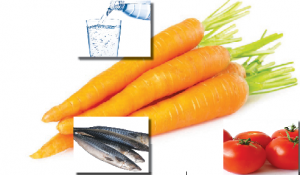 a lot of time and resources in beauty products, in their quest for a
velvety skin. A beauty expert once said that trying to obtain smooth
skin by slathering chemicals on the outside will only lead to
disillusionment and frustration, not to mention ill-health and expense.
a lot of time and resources in beauty products, in their quest for a
velvety skin. A beauty expert once said that trying to obtain smooth
skin by slathering chemicals on the outside will only lead to
disillusionment and frustration, not to mention ill-health and expense. Smooth skin comes from the inside out.
Smooth skin comes from the inside out.“Most of your skin’s health and its ability to react to stress, damage and the environment rely more on lifestyle, and a great place to start
 is with the foods you eat,” according to Princess Adegbohun of Priceless Beauty.
is with the foods you eat,” according to Princess Adegbohun of Priceless Beauty.She added that it is better to settle for natural foods to get
 firmer skin, fight wrinkles and enjoy a glowing, youthful skin
firmer skin, fight wrinkles and enjoy a glowing, youthful skinOn why some people do not tread this nature’s path, Adegbohun disclosed: “Very few people have the patience it takes for the result to start
 manifesting. It may take up to three months before it starts showing, unlike the effects of chemicals.”
manifesting. It may take up to three months before it starts showing, unlike the effects of chemicals.”The wonder foods
Dehydration is an enemy of the skin, resulting in wrinkles. The best way to deal with this is by drinking at least six glasses of clean water every day. If this poses a challenge, one
 can resolve to fruits like watermelon that is high in water content,
instead of consuming processed fruit juices or carbonated drinks.
can resolve to fruits like watermelon that is high in water content,
instead of consuming processed fruit juices or carbonated drinks.
Fruits – Aside the harmful chemicals in many beauty products, they also contain traces of fruit extracts, while organic products make use of mainly fruits and vegetables. But Tosin Omodun, a nutritionist, advises that people should make fruit eating a priority.
“Take avocado, for instance; it is mostly used as a face mask. But if it is eaten, one
 will get
will get all the benefits. It contains foliate which helps blood formation. It
is essential for oil generation, and the rich monounsaturated fat in it
will lead to a clear, soft and smooth skin,” Omodun explained.
all the benefits. It contains foliate which helps blood formation. It
is essential for oil generation, and the rich monounsaturated fat in it
will lead to a clear, soft and smooth skin,” Omodun explained.The Vitamin A in carrot prevents the over-production of skin cells which can lead to clogged pores and skin cancer, while the antioxidant in the peel of apple protects against sun damage.
Colourful vegetables – Nutritionists have said that one
 should opt for vegetables that have deep intense colours: yellow, orange, green and red.
should opt for vegetables that have deep intense colours: yellow, orange, green and red.Green vegetables are great sources of essential Vitamin E, which is essential for healthy skin; it helps restore skin cells and also build muscle and tissue, thus keeping skin firm and helping to prevent wrinkles.
According to Funmi Sanyaolu, an agriculturist, spinach is rich in iron which aids circulation by carrying vital oxygen and vitamin K which may help prevent varicose veins.
The lycopene compound contained in tomatoes is a powerful antioxidant that eliminates skin-ageing free radicals from ultra-violet exposure. It has been researched that red bell peppers (tatase in Yoruba) contain more vitamin C than an orange, and the spicier peppers contain a compound that improves blodd circulation and promotes the release of toxins from the skin.
Oils – Taken in moderation, the different oils used in cooking are good for the body, but the ones great for the skin are palm oil, coconut oil and olive oil. They provide some sun protection, fight bacteria, and help soften skin with omega 6 fatty acids.
Omega-3 fatty acids are high in vitamin D that helps keep the skin fresh and promote an overall healthy appearance. You can either get
 this acid from salmon and tuna fishes or fish oil capsules for those who dread eating fish.
this acid from salmon and tuna fishes or fish oil capsules for those who dread eating fish.In what may seem difficult, Omodun advised against eating fried foods, white sugar, white rice and white potatoes. “Whole grains and sweet potato are your
 best bet,” she said.
best bet,” she said.It is not all about food, one should stay away from caffeine, smoking and prolonged exposure to the sun, as they damage the skin and make it age faster.
Exercises and a good night sleep is also essential.Eat your way to a glowing skin
